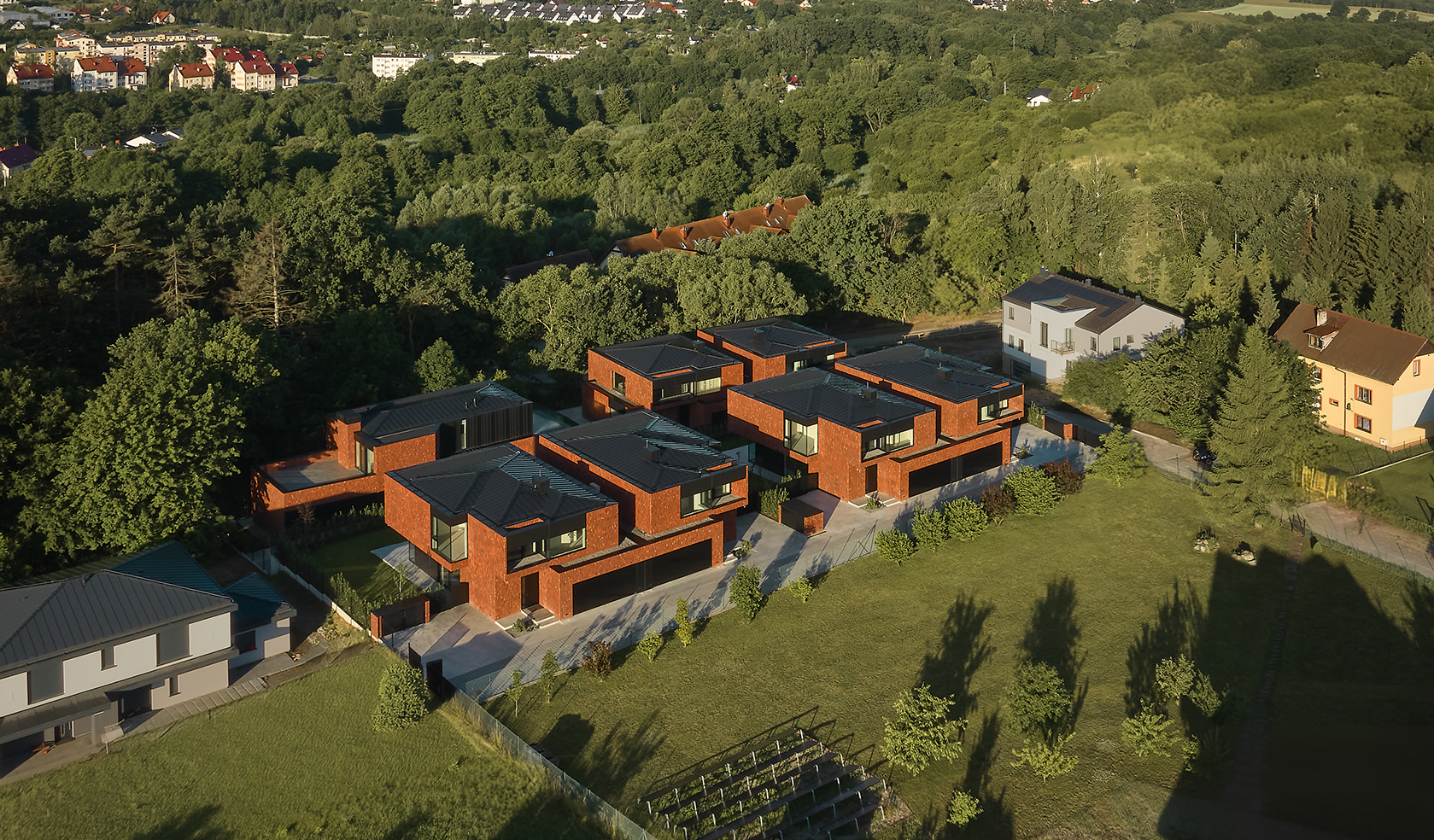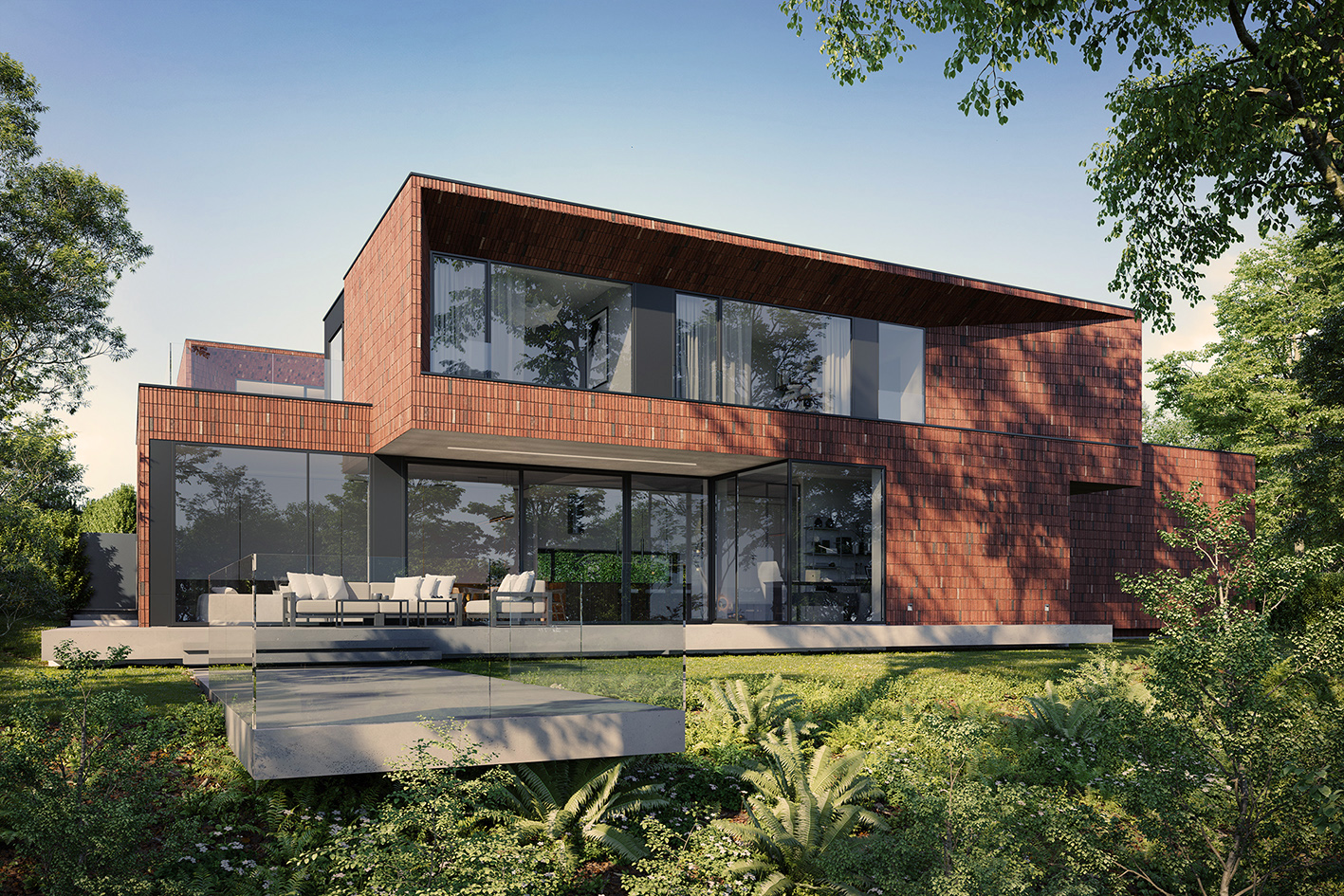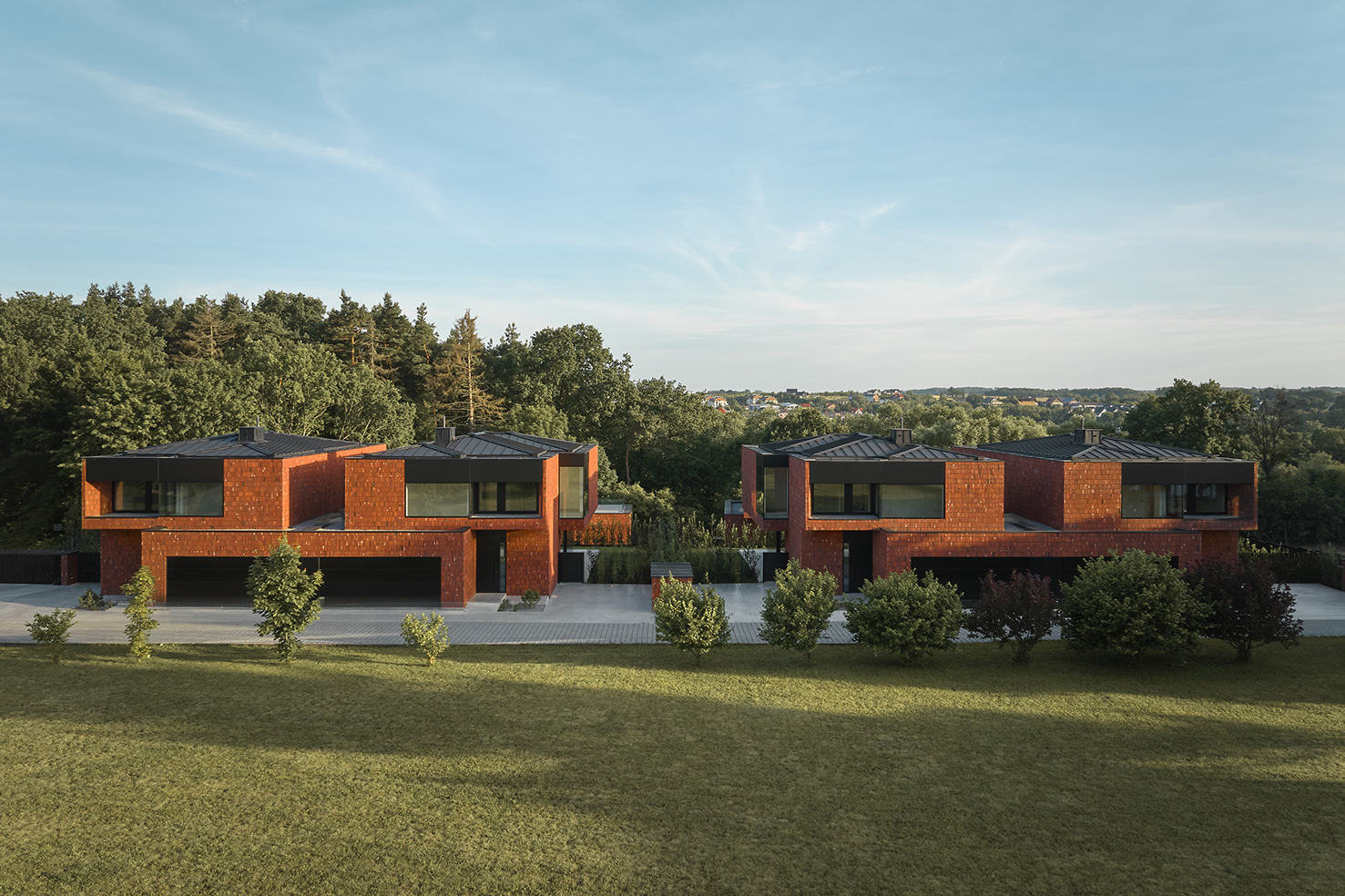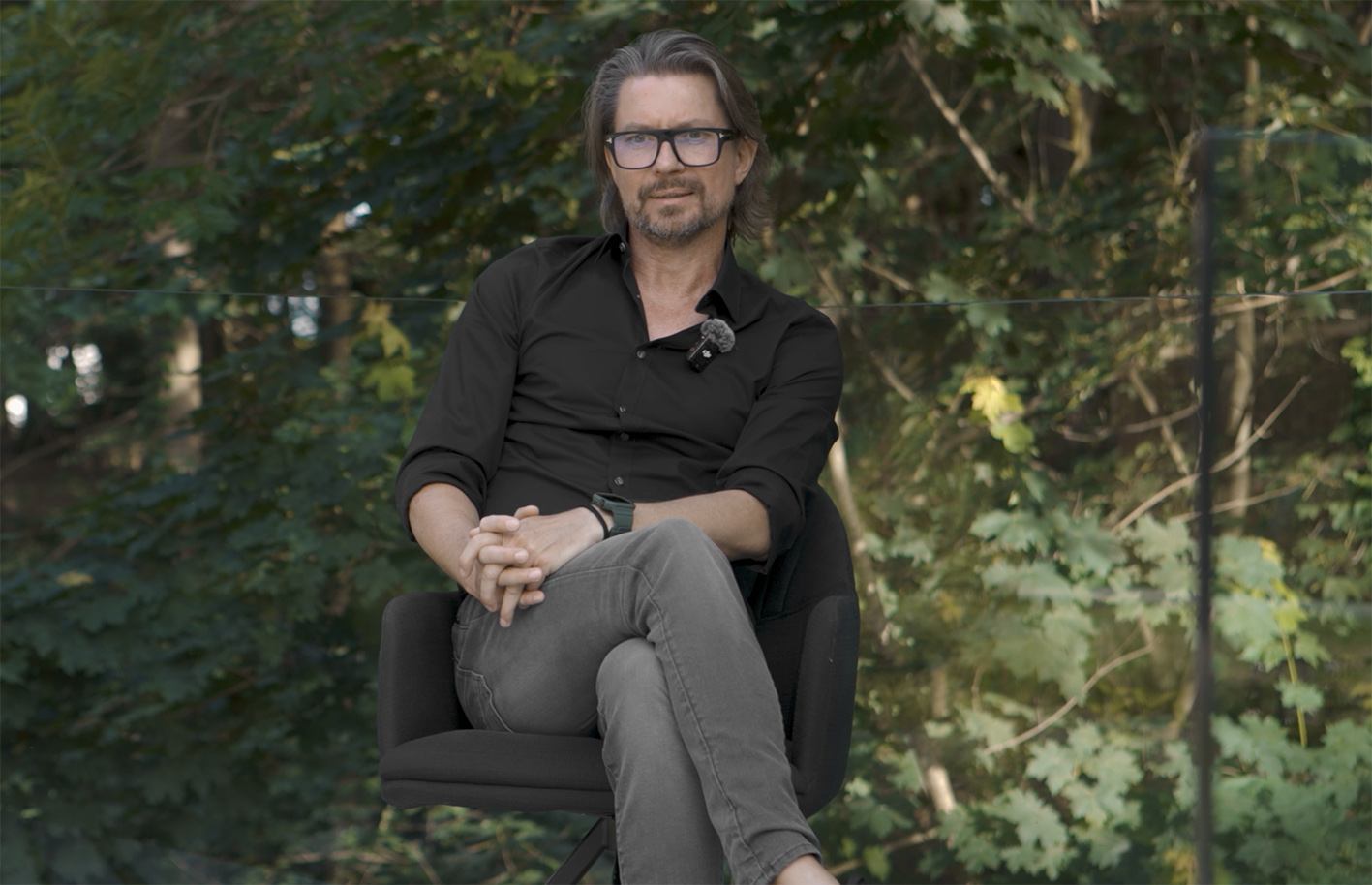Straszyn is a quiet village full of greenery located only 12 km from the centre of Gdansk. The site of the investment is a sloping area, which descends towards the south and ends in a scarp overgrown with old trees. In this picturesque place, we designed an intimate complex of houses, which was named RUBRA because of its brick-red colour.
In search of inspiration.
It turned out that the church of St. Jacek Odrowąż stands right next to the planned investment, and in its contemporary form, emphasised by the triangular form of the roof, one can find traces of traditional architecture for Żuławy and Pomerania. The church was designed by the eminent architect Professor Szczepan Baum.
This way of thinking about architecture is very close to my heart. When designing our estate, we tried to refer to the construction past of the region. The overhanging storeys are reminiscent of the arcaded houses that were characteristic of Żuławy as early as the 17th century, and the form of the walls and canopies inclined at an acute angle can be found in typical timber-frame constructions with diagonal braces.
Another inspiration was the picturesque plot of land, sloping towards the south and ending in a wooded slope.
Consequently, we designed the buildings in a cascade arrangement which allowed them to fit properly into the sloping terrain. As a result, each house has a better view, more light and a south-facing terrace and garden.
Why did we opt for clinker on the facade.
Hand-moulded brick or a clinker tile derived from it is an extremely graceful material for an architect. It has a good origin, correct proportions and looks great on the façade.
Hand-moulded bricks have been used in our project area for many centuries. Among other things, it was used to build free-standing bread ovens.
The clinker which covers the facades of the designed buildings is a reference to the architecture which was created here in the inter-war period. One could mention the remains of railway station buildings, residential houses or the mill building - all erected in Pruszcz Gdański at the turn of the 20th century. The most important inspiration in this respect are the still existing hydroelectric power plants erected on the Radunia River since the beginning of the 20th century.
Rubra housing estate and its structure
From the very beginning of our cooperation with Mr Piotr Dorozik - the Investor and also the General Contractor of the entire investment - it turned out that we speak the same language. The Investor is a man who does not recognise shortcuts and is able to solve problems creatively. He understands the demanding architecture and the complicated process that accompanies its proper execution.
The estate consists of six semi-detached buildings and one free-standing building. The buildings are arranged in a cascade, which allows them to relate to one another.
The developer's dream was a flat roof. This made extra sense from the point of view of the cascade development. Buildings positioned at the top of a sloping plot can have a better view from the storey above the buildings below. A hipped roof with a steeper pitch effectively prevents this. The local development plan did not allow for a flat roof, but allowed for a roof with a small 12-degree pitch. We made use of this possibility and from a human level such roofs are practically invisible.
From the very beginning we were agreed that the characteristic material for the façade would be red hand-moulded bricks. We opted out of full brick on the façade due to the large thickness of the external wall and the limited size of the development. We decided to use clinker tiles in a vertical pattern. I really like this rhythm because, unlike the wild bond, the tile does not pretend to be full brick. It is 100% itself.
In order to obtain the required number of tiles, some 100,000 handmade bricks were cut. As each brick differs in size from the next, each of the cut bricks had to be processed by hand. Only then could they be laid vertically in regular horizontal lines.
Landscape architect Magdalena Dorozik designed the greenery for the entire estate. All buildings have individually designed and constructed gardens, an irrigation system using recycled rainwater and lighting. The slope retains the old trees and the entire estate has been given a lot of new planting.
The entrance gates and wickets are made of solid aluminium panels and the drive mechanism is concealed in the driveways.
A new road and pavement were built on the difficult sloping terrain as part of the access to the project, benefiting the entire neighbouring development.
Semi-detached houses. A, B, C
Each type A and B semi-detached house has 236m2 of floor space and a 2-car garage. Type C houses look slightly different and each have 233m2 of floor space and a 2-car garage.
On the ground floor, in addition to the living room with kitchen, there are also study rooms. The floors have 4 rooms, two bathrooms and a boiler room with laundry.
The ground floors, which are 3 m high, are glazed with aluminium framed windows and equipped with an HS sliding system. All windows have been flush with the façade and set on projecting consoles outside the face of the structure.
Each building has concrete terraces raised above the ground on the south side. This required a very strict technological regime, as the final parameters of the surface layer of ready-mixed concrete had to meet the requirements of the changeable and harsh climate of northern Poland. To this end, a bridge concrete with metallurgical cement was used, which additionally guaranteed us a light shade of concrete. The result is a 20 cm thick, weather-resistant, monolithic slab with a finished surface. The terrace steps were also made in a similar way.
In order to emphasise the separate character of the semi-detached buildings, I have decided to move the adjacent storey blocks away from each other.
A characteristic element of these houses is the form of the overhanging canopies of the first floor. It protects against excessive heat build-up in the rooms on the south side, and its diagonal terraces and walls add dynamism to the whole body of the building.
Each garage door is flush with the façade. As Horman did not foresee this type of system solution for the installation of its doors, it was necessary to use consoles, to think about and design such a detail.
Detached house type D
I am particularly pleased that we were able to build a detached house in a very charming location on the estate - right in front of a slope overgrown with old trees.
The detached house has 267 m2 of floor space and a 2-car garage.
On the ground floor, in addition to the living room and dining room with kitchen, there is a study. On the first floor we have designed 4 rooms and two bathrooms, as well as laundry and boiler rooms.
This is a house with a unique character. Due to the sloping terrain of the plot, the ground floor has literally been driven below the level of the entrance. It has a distinctive longitudinal window that looks like a crack in the rock wall. The garage is separated from the living area by a glass-enclosed corridor. This creates the effect that when entering the house, one is greeted by a view of the trees on the other side.
The first-floor block on the entrance side has been clad in seamed sheet metal and cut with vertical windows that extend to the edge of the canopy. On the south side, the house has a terrace with a magnificent view of the old trees.
Since the slope of the slope also belongs to the developer, we decided to take advantage of this. Building D therefore gained an additional terrace in the form of a concrete footbridge hanging in the air.
Summary:
It must be emphasised that the architect is responsible for the design, but the Investor and the contractor are largely responsible for how the architecture he designed will look in the end. In the case of Rubra, the investor did not "optimise" the solutions at the expense of the quality of the architecture, but strove to implement them in accordance with the design. He deserves sincere praise for his work. You can see that he derives real joy from this type of realisation.
The architecture of the Rubra estate is a contemporary interpretation of the historical buildings in the region. The simple blocks stacked on top of each other, the sloping walls of the overhangs and the red of the burnt clinker give them a coherent, timeless character. The houses have cascaded into the sloping ground. All this makes the architecture of the estate fit in with the unusual plot and the whole context of the historic buildings of the Żuławy region. This is one of our favourite projects.
RUBRA RESIDENCE. STRASZYN NEAR GDANSK.
FUNCTION: Estate of 7 semi-detached and detached houses
LOCATION: Straszyn near Gdańsk, Jasia and Małgosia Street
FLOOR AREA: 1645m2
YEAR: 2021 DESIGN, 2024 IMPLEMENTATION
INVESTOR/GENERAL CONTRACTOR: HERZ INVEST: mgr inż. Piotr Dorozik
ARCHITECT/AUTHOR: mgr arch. Paweł Lis,
CO-OPERATION: mgr. arch. Karolina Osuchowska, mgr. arch. Piotr Gorzelańczyk
Greenery design: arch. Magdalena Dorozik
CONSTRUCTION:mgr inż. Darek Gardziński


























